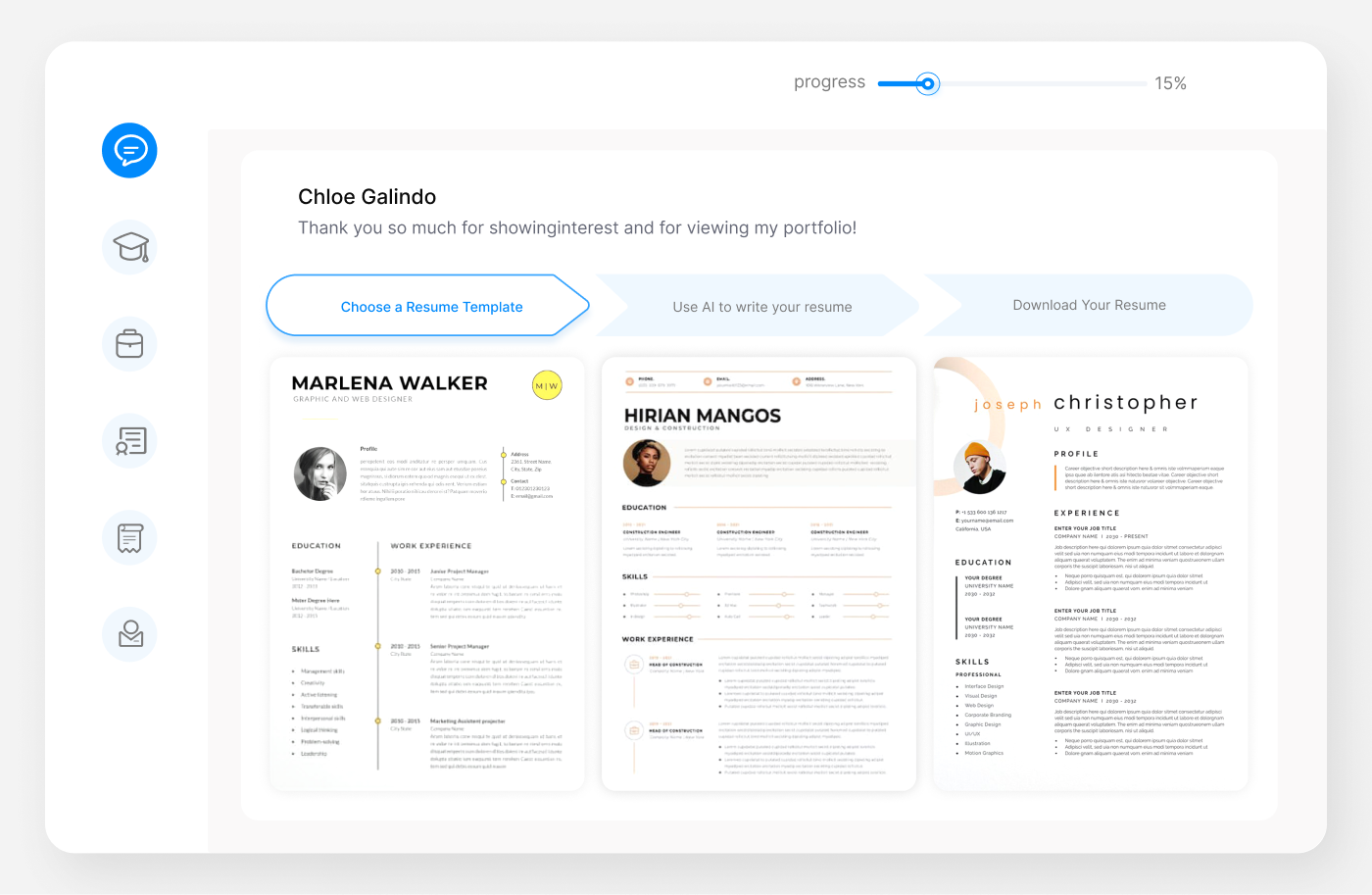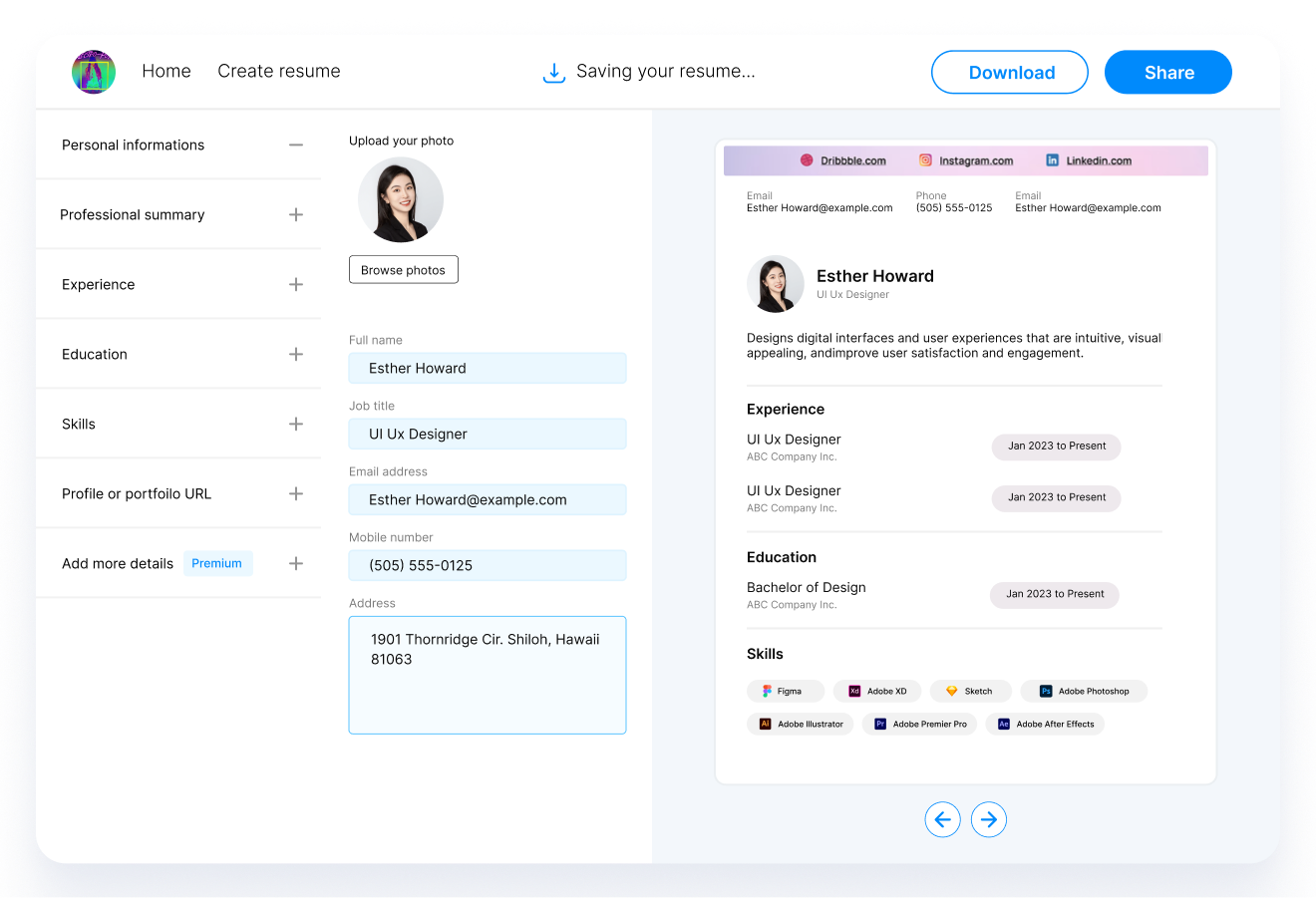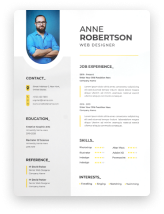In the competitive field of architecture, standing out from the crowd with a compelling resume is crucial. This guide will equip you with everything you need to know about crafting a resume that not only highlights your architectural skills and experiences but also captures the essence of your professional journey. Whether you're a seasoned architect looking to take your career to the next level or a recent graduate aiming to make your mark in the industry, this guide is your blueprint to creating a resume that resonates with hiring managers.

Architect Resume Example
Jessica Lin
Licensed Architect | LEED AP BD+C
Email: jessica.lin@archimail.com
Phone: (555) 123-4567
LinkedIn: linkedin.com/in/jessicalinarchitecture
Professional Summary:
Innovative and dedicated licensed architect with over 8 years of experience in designing sustainable commercial buildings and residential projects. Expertise in project management, sustainable design, and client relations, with a proven track record of leading high-performance teams to complete projects on time and within budget. Skilled in Revit, AutoCAD, SketchUp, and Adobe Creative Suite.
Work Experience:
Senior Architect, GreenSpace Architects, New York, NY
March 2018 – Present
- Led a team of 10 in the design and completion of over 20 sustainable commercial projects, with budgets up to $10 million.
- Spearheaded the implementation of innovative design techniques that reduced project costs by 15% while maintaining quality and sustainability standards.
- Enhanced client satisfaction through effective communication and project management, resulting in a 30% increase in repeat business.
Project Architect, BuildRight Design Group, Los Angeles, CA
July 2013 – February 2018
- Managed architectural design projects from concept through completion, collaborating with clients, engineers, and construction teams.
- Specialized in residential projects, achieving a 25% increase in energy efficiency through the use of advanced materials and technologies.
- Conducted comprehensive site and environmental impact assessments to ensure compliance with local zoning laws and sustainability goals.
Education:
Master of Architecture (M.Arch.), University of California, Berkeley
September 2011 – June 2013
Bachelor of Science in Architecture, University of Southern California
September 2007 – June 2011
Skills:
- Proficient in Revit, AutoCAD, SketchUp, and Adobe Creative Suite
- Strong understanding of sustainable design principles and LEED guidelines
- Excellent project management and leadership abilities
- Effective communicator with exceptional client relations skills
Certifications:
- Licensed Architect, State of New York
- LEED Accredited Professional (LEED AP BD+C)
Professional Memberships:
Crafting an Architect's Resume: A Blueprint for Success
When structuring your architect resume, think of it as designing a building. It must be functional, aesthetically pleasing, and easy to navigate. Your resume should reflect your architectural style—clean, precise, and impactful. Here's how to construct it from the ground up.
Foundation: The Basics
Start with your contact information at the top. Include your name, phone number, email, and LinkedIn profile. Make sure your email sounds professional.
Use a professional email address that includes your name, such as firstname.lastname@email.com. Avoid using outdated or unprofessional email addresses like archidude@email.com.
The Facade: Choosing the Right Resume Format
Your resume's format is its facade. It's the first thing hiring managers notice, so choose a layout that showcases your strengths. The chronological format is most common and preferred if you have a straightforward career path. However, a functional or combination format can highlight your skills over less linear work history, beneficial for those with gaps in employment or changing careers.
Chronological Format:
- Work Experience
- Most Recent Job
- Previous Job
- Earliest Job
- Education
- Skills
Functional Format:
- Skills
- Skill 1
- Skill 2
- Skill 3
- Work Experience
- Education
Structural Integrity: Resume Sections
Organize your resume into clear, distinct sections: Professional Summary, Work Experience, Education, Skills, and any additional sections relevant to your role as an architect, like Certifications or Projects.
- About Me
- Jobs I've Had
- Schools I Went To
- Things I'm Good At
- Random Certifications
- Stuff I've Done
Professional Summary or Objective: Your Design Philosophy
This section is like your design philosophy—concise yet profound. A well-crafted summary or objective gives a snapshot of your career highlights and skills. For experienced architects, focus on your achievements, specialized skills, and what you bring to the table. New graduates or career changers should emphasize their objective, relevant skills, educational background, and how they align with the company's goals.
Tailor your resume to the specific job you're applying for. Research the company and the role, and highlight the skills and experiences that directly relate to their needs.
Work Experience: Showcasing Your Portfolio
Detail your professional experience, starting with your most recent job. Use action verbs to describe your responsibilities and achievements. Quantify your successes with numbers when possible, such as the size or cost of projects you've worked on or the efficiency improvements you implemented. Highlight experience with sustainable design, project management, and software proficiency.
Senior Architect, GreenSpace Architects, New York, NY
March 2018 – Present
- Led a team of 10 in the design and completion of over 20 sustainable commercial projects, with budgets up to $10 million.
- Spearheaded the implementation of innovative design techniques that reduced project costs by 15% while maintaining quality and sustainability standards.
- Enhanced client satisfaction through effective communication and project management, resulting in a 30% increase in repeat business.
Education: The Foundation of Your Career
List your highest degree first, including the degree name, school, and graduation year. If you're a recent graduate, you can include relevant coursework, honors, or extracurricular activities. Experienced professionals should keep this section succinct, focusing on degrees and certifications that directly relate to architecture.
Master of Architecture (M.Arch.), University of California, Berkeley
September 2011 – June 2013
Bachelor of Science in Architecture, University of Southern California
September 2007 – June 2011
High School Diploma, Generic High School, Anytown, USA
September 2003 – June 2007
Elementary School, Generic Elementary School, Anytown, USA
September 1997 – June 2003
Skills: The Tools in Your Drafting Table
This section should be a curated list of skills that align with the job you're applying for. Include technical skills like AutoCAD, Revit, and SketchUp, as well as soft skills such as project management and communication. Be specific; instead of "experienced in software," list the exact programs you're proficient in.
Additional Sections: Enhancing Your Resume
Consider adding sections for certifications, awards, publications, or projects. For architects, relevant certifications might include LEED accreditation or a Registered Architect (RA) license. If you've been published in architecture journals or have notable projects, include these to distinguish your resume further.
Certifications:
- Licensed Architect, State of New York
- LEED Accredited Professional (LEED AP BD+C)
Professional Memberships:
Hobbies:
- Playing video games
- Watching reality TV
- Sleeping
Cover Letter: The Personal Touch
Your cover letter is where you can express your enthusiasm for the role and how your experiences and ambitions align with the company's goals. It's also a chance to explain anything not covered in your resume, such as career gaps or projects relevant to the job.
Work Experience: Building Your Professional Legacy
Crafting the work experience section of your architect resume is like laying out the blueprint of your career. It's where you detail the structures you've helped to design and build, not just with concrete and steel, but with creativity, foresight, and expertise. Here's how to construct this cornerstone:
-
List Your Roles in Reverse Chronological Order: Start with your current or most recent job and work backward. This format showcases your progression and current level of responsibility.
-
Use Action Words to Describe Your Responsibilities and Achievements: Begin bullet points with dynamic verbs like "designed," "led," "coordinated," or "implemented" to create a powerful and impactful impression.
-
Quantify Your Achievements: Where possible, add numbers to give scale to your achievements. For example, "Managed a team of 10 in the design of a 30-story residential building" or "Reduced project costs by 20% through efficient design and material selection."
-
Highlight Projects That Align With the Job You're Applying For: Tailor your resume to the job. If the position emphasizes sustainable design, highlight your experience in this area.
-
Include Collaborations: Architecture is a collaborative field. Mention your experience working with contractors, engineers, and clients to show your teamwork and communication skills.
Education: The Framework of Your Expertise
In the architecture field, your educational background lays the groundwork for your career. Here's how to effectively present your education on your resume:
-
Start With Your Highest Degree: List your degrees in reverse chronological order, beginning with the most recent.
-
Include the Name of the Institution, Degree, and Graduation Year: This basic information helps recruiters quickly understand your academic qualifications.
-
Mention Relevant Coursework or Projects: Especially for recent graduates, detailing specific courses or projects can showcase your expertise and readiness for the role.
-
Add Honors or Awards: If you graduated with honors or received notable awards, including these can further distinguish your resume.
Remember, each section of your resume, from work experience to education, should be meticulously crafted to showcase your talents, achievements, and the value you would bring to a potential employer. By paying attention to detail and tailoring your resume to the job at hand, you can construct a document that not only represents your career but also paves the way to your future successes in the field of architecture.
Mastering the Skills Section: The Architect's Toolbox
The skills section of an architect's resume is akin to a well-organized toolbox. Each tool represents a skill essential for executing projects with precision and creativity. Here are the tools you should consider including:
-
Technical Skills: Highlight software skills critical to modern architecture, such as AutoCAD, Revit, SketchUp, Rhino, and Adobe Creative Suite. Specify your level of expertise in each tool.
-
Design & Planning: Showcase your ability to conceptualize and execute project designs, understanding of architectural principles, and proficiency in space planning and sustainable design.
-
Project Management: Include skills related to overseeing projects from conception to completion, such as budgeting, scheduling, and coordinating with contractors and clients.
-
Communication: Architects must effectively communicate ideas to clients, contractors, and team members. List both verbal and written communication skills.
-
Problem-Solving: Highlight your ability to navigate challenges during the design and construction processes, ensuring projects meet all requirements and constraints.
Enhancing Your Resume with Additional Sections
Beyond the standard sections, consider adding elements that can make your architect resume stand out:
-
Certifications: Include relevant certifications such as LEED Accredited Professional or Registered Architect status. These add credibility and showcase a commitment to your profession.
-
Awards & Recognitions: If you've received awards or recognitions, either individually or as part of a team, include these to highlight your excellence in the field.
-
Professional Memberships: Being part of professional organizations like the American Institute of Architects (AIA) indicates your active engagement in the architectural community.
-
Volunteer Work: Related volunteer work can demonstrate your passion and commitment to using your skills for community benefit.
-
Projects: Listing significant projects where you played a key role can provide concrete examples of your capabilities and achievements.
Cover Letter: A Personal Architectural Narrative
Your cover letter should be the narrative that complements the structured data of your resume. It's an opportunity to express your passion for architecture, discuss your design philosophy, and explain how your experiences align with the company's projects and values. Use it to tell the story behind the buildings you've helped to create, making your application memorable and engaging.
Remember, every section of your architect resume, from the skills to the additional sections, should be meticulously tailored to showcase your unique contributions to the field of architecture. Like a well-designed building, your resume should balance form and function, leaving a lasting impression on those who view it.
Crafting a Compelling Cover Letter for Architects
Writing a cover letter for an architect position is akin to drafting the initial concept for a building—it requires thought, creativity, and an understanding of the structure (or company) you aim to contribute to. This document is your chance to convey your passion for architecture, highlight key projects, and demonstrate how your skills align with the company's vision and projects.
Start by addressing the letter to the hiring manager by name, if possible. Open with a strong introduction that captures your enthusiasm for the role and the field of architecture. Briefly mention your most significant achievements or a project that exemplifies your capabilities and aligns with the company's work.
In the body, delve into your architectural philosophy, your approach to challenges, and specific skills or experiences that make you the ideal candidate for the position. If there are gaps in your resume or unique career paths you've taken, the cover letter offers a chance to explain these aspects in a positive light.
Conclude by reiterating your interest in the role and the value you bring. Express your eagerness to discuss further how you can contribute to their team, and thank the reader for considering your application.
Final Thoughts: Constructing Your Future in Architecture
As you finalize your architect resume and cover letter, remember that these documents are more than just a list of skills and experiences—they are a testament to your journey in the world of architecture. They reflect your passion, your architectural philosophy, and your readiness to tackle new challenges.
Before sending off your application, review everything meticulously. Ensure that your resume and cover letter are not only free of errors but also clearly convey your strengths and the unique qualities you bring to the table. Consider seeking feedback from mentors or peers in the architecture field, as they can offer valuable insights.
With a well-crafted resume and cover letter in hand, you're ready to step into the next phase of your architectural career. Whether you're aiming for a role at a cutting-edge design firm or a position that allows you to contribute to sustainable urban development, your application is the first step towards realizing those professional aspirations.

Frequently Asked Questions About Writing an Architect Resume
Q1: How long should my architect resume be?
A: For most professionals, a one to two-page resume is ideal. It should be concise yet comprehensive enough to showcase your relevant experiences and skills.
Q2: Should I include all my projects in the resume?
A: Focus on projects that are most relevant to the job you're applying for. Highlighting key projects where you played a significant role is more effective than listing all your work.
Q3: How can I stand out with my architect resume?
A: Tailor your resume to the job description, use keywords relevant to the role, and highlight unique experiences or projects. A well-designed resume layout that reflects your architectural style can also make a visual impact.
Q4: Is a cover letter necessary for an architect position?
A: Yes, a cover letter allows you to personally connect with the employer, explain your architectural approach, and highlight why you're the perfect fit for their team. It's an opportunity to provide context to your resume and showcase your personality.
By addressing these FAQs and following the guidance provided in this comprehensive guide, you're well-equipped to craft a resume and cover letter that will help you build your career in architecture.
Recommended Reading









